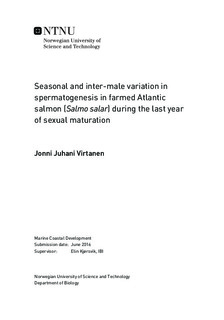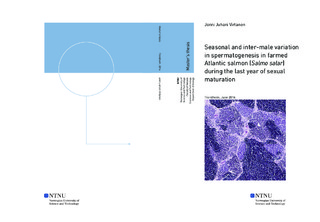| dc.description.abstract | Reproductive patterns in male teleost fish have received relatively little attention compared to those of their female counterparts. Testis maturation and progression in spermatogenesis are usually described with a combination of weight-based gonadosomatic index (GSI) and nominal classification based on histological analysis. Quantitative histological assessments are rare. In salmon aquaculture, breeding companies try to operate as efficiently as possible and additional knowledge of the timings and durations of the phases of spermatogenesis and the differences between individual fish could be useful in enhancing the production.
In the present study, the progression of spermatogenesis was observed in broodstock Atlantic salmon (Salmo salar) in the course of their last year of sexual maturation. A quantitative histological assessment was made by determining the spermatogenic maturity index (SMI) from 115 fish that were sampled during this period. SMI describes the maturation on a scale from 0 to 1 and is based on the area fraction estimations of different cell types in a histological section. The SMI was related to GSI and seasonal and inter-male variations were surveyed. The same fish were also examined with ultrasound and an ultrasound based GSI was established. The accuracy of ultrasound measurement was evaluated by comparing the ultrasound measurements to the true volumes and finally the applicability of ultrasound examination as a basis for sorting the fish to early and late spawners was evaluated.
The SMI correlated with GSI very well until the end of the meiotic phase when GSI reached peak mean values of 4.8 and started to decline while SMI kept growing until the end of the experiment. Both indexes remained low until the fish were transferred to fresh water and rapid proliferation of germ cells begun. Largest variations in testis size between individual fish were found in July when spermatocytes were the dominating cell type, all the fish were at meiotic phase and mean SMI was ~0.5. After the fish entered spermiogenic phase, GSI declined to a stable mean of 3.8 and SMI rose steadily to 0.91.
The ultrasound measurements were relatively inaccurate and there was too much inconsistency for reliable estimations on final milt volumes. However, the measurements could be easily improved and even now, the ultrasound could be used as a basis for sorting the fish to early and late spawners. It would be important to perform the sorting when the fish are at meiotic phase, when the individual differences are largest and the testis size has not started to decline, making it quite safe to assume that the biggest testes are the most mature ones. | |

